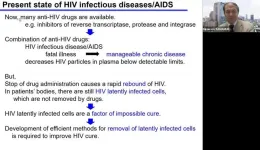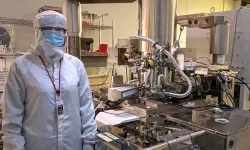(Press-News.org) In a new study titled, “Understanding Feeling ‘High’ and Its Role in Medical Cannabis Patient Outcomes,” published in the journal, Frontiers in Pharmacology, researchers at The University of New Mexico, in collaboration with Releaf App™ found that patients who reported feeling “High” experienced 7.7% greater symptom relief and an increase in reporting of positive side effects such as “Relaxed” and “Peaceful.” However, these benefits must be weighed against a more than 20% increase in negative side effect reporting.
Senior author and Associate Professor of Psychology, Jacob Vigil, explained the motivation for the paper. “Feeling ‘high’ is poorly defined in the scientific literature, but is generally associated with both impairment and feelings of euphoria," said Vigil. "Typically, feeling ‘high’ is assumed to be the goal of recreational use, but a limitation to cannabis’ therapeutic potential. In this paper, we test the validity of this assumption and find that feeling ‘high’ may be an unavoidable component of using cannabis medicinally.”
In the study sample of almost 2,000 patients, who recorded more than 16,000 medical cannabis administration sessions using cannabis flower, the study found that 49% of participants reported feeling high. Feeling high was highly correlated with a variety of side effects. The most highly correlated positive side effects were “chill” and “happy,” while the most highly correlated negative side effects were “dry mouth” and “red eyes.” Conventional definitions of feeling high typically involve impairment and euphoria, which was supported by the study results – feeling high was statistically significantly associated with feeling clumsy, confused, dizzy, foggy, and paranoid, and well as effects like happy, grateful, great, and optimistic.
With respect to symptom relief, the study found strong positive correlations between feeling high and greater symptom relief, even after controlling for THC and CBD levels, dose, mode of consumption (pipe, joint, vaporizer) and starting symptom severity. This suggests that feeling high may be a fundamental component of the effective use of cannabis as medicine, rather than a tangential, negative effect to be avoided in clinical settings.
THC levels were most strongly associated with feeling high while using a vaporizer rather than combusting the cannabis flower was associated with a reduced likelihood of feeling high. Prior work has shown that THC levels also are strong predictors of symptom relief, but the results of this study show that higher THC levels no longer are statistically significant predictors of symptom relief once feeling high is included. In other words, higher THC increases symptom relief only if the patient feels high. However, THC remains an independent predictor of negative side effects, even after controlling for whether a patient felt high.
The study found the results held for both male and female patients, across pre-app cannabis experience levels, and for symptoms including anxiety, depression, pain and fatigue. However, feeling high did not increase symptom relief among individuals with insomnia and the association between feeling high and improved symptom relief was weaker among patients over 40, suggesting heterogeneity in the relationship across individual users and uses.
According to lead author and Associate Professor of Economics, Sarah Stith, the results of this study highlight the challenges of using cannabis a medicine. “Cannabis products are extremely variable in their phytochemical composition and patients vary extensively beyond even factors included in this study, such as symptom type, gender, age, and cannabis experience," said Stith. "In addition, factors that increase symptom relief, such as feeling high and THC, are associated with increased negative side effects such as impairment. These complexities suggest that the future of cannabis-as-medicine lies in highly customized treatments rather than the conventional pharmaceutical model of standardized dosing for most patients.”
The study concludes with recommendations for stakeholders. Clinicians should be aware that feeling high is likely a key component of effective medical cannabis treatment for many patients. Policymakers should recognize that what may be deemed “recreational” use may lead to unintended health benefits as feeling high is associated with increased symptom relief for a variety of common conditions.
The cannabis industry should be cautioned against its apparent drive for ever-higher THC levels; THC levels, after controlling for whether or not a person feels high, do not increase symptom relief but do increase negative side effects and may lead to increased medication non-compliance among medical patients. Future researchers should consider the relationship between feeling high and patient outcomes for cannabis products beyond flower, including concentrates with significantly higher THC levels and edibles widely used by medical patients, as well as the role of phytochemicals beyond THC and CBD.
END
Screening newborns for severe combined immunodeficiency disease (SCID) significantly increases the survival of children after bone marrow transplantation, a new North American study finds.
Published today in The Lancet with an accompanying editorial, the retrospective study was co-led by Elie Haddad, an Université de Montréal medical professor and clinician scientist, pediatrician and immunologist at the UdeM-affiliated CHU Sainte-Justine mother-and-child hospital.
The research shows that the gradual adoption of newborn screening for SCID since 2008 in North America has boosted the survival rate from 73 per cent between 1982 and 2009 to ...
Specially designed gardens could reduce the amount of a toxic chemical associated with tires entering our waterways by more than 90 per cent, new research shows.
Tired toxins
The chemical 6PPD-quinone can form when car tires interact with the atmosphere. It enters rivers and streams when rain runs off roads into waterways. It is toxic to coho salmon, rainbow trout and some other fish.
“Rain gardens”, or bioretention cells, are gardens engineered to reduce flooding and soak up contaminants when road runoff is directed ...
One of the main reasons plants use water is to allow them to absorb carbon dioxide from the atmosphere. This means that, in plants, the water and carbon cycles are tightly linked. In a new study, researchers from the University of Missouri and the United States Department of Agriculture (USDA) used this foundational principle to identify sustainable farming practices aimed at helping staple crops like corn and soybeans thrive during extreme weather conditions that have become more common in the Midwest.
This study examined how farming practices affect crop resilience to climate change by examining water and carbon ...
SAN FRANCISCO — PLOS today is announcing that it will soon launch two new journals: PLOS Mental Health and PLOS Complex Systems. PLOS sees these new journals as an opportunity to give evolving research communities opportunities to forge a new path for research in the field. Whether that means welcoming new ways of sharing research transparently or cementing new policies that enable research to be evaluated and rewarded more fairly, or simply finding a broader audience where research can make a greater real-world impact.
PLOS Mental Health provides a dedicated venue for all mental health research, connecting global experts from a broad range of disciplines and addressing challenges ...
A research team led by Tokyo Medical and Dental University (TMDU) has identified a molecular compound that activates latent HIV-1 in cells, showing promise for HIV treatments
Tokyo, Japan – A multi-institutional research group led by researchers from Tokyo Medical and Dental University (TMDU) has made a significant and promising step forward in our ability to treat human immunodeficiency virus type 1 (HIV-1), the virus underlying acquired immunodeficiency syndrome (AIDS).
To appreciate their accomplishment, we must first know a little about why HIV-1 is difficult to eliminate. ...
– By Will Ferguson
For the first time, researchers at the Department of Energy’s Lawrence Berkeley National Laboratory (Berkeley Lab) have developed a genome-scale way to map the regulatory role of transcription factors, proteins that play a key role in gene expression and determining a plant’s physiological traits. Their work reveals unprecedented insights into gene regulatory networks and identifies a new library of DNA parts that can be used to optimize genetic engineering efforts in plants.
“Transcription factors regulate things like how plants grow, how much fruit they produce, ...
CHAMPAIGN, Ill. — Fifteen years of archaeological work in the Tam Pa Ling cave in northeastern Laos has yielded a reliable chronology of early human occupation of the site, scientists report in the journal Nature Communications. The team’s excavations through the layers of sediments and bones that gradually washed into the cave and were left untouched for tens of thousands of years reveals that humans lived in the area for at least 70,000 years – and likely even longer.
“When we first started excavating the cave, we never expected to find humans in that region,” said University of Illinois Urbana-Champaign anthropology professor Laura Shackelford, who led ...
A new tool for generating microwave signals could help propel advances in wireless communication, imaging, atomic clocks, and more.
Frequency combs are photonic devices that produce many equally spaced laser lines, each locked to a specific frequency to produce a comb-like structure. They can be used to generate high-frequency, stable microwave signals and scientists have been attempting to miniaturize the approach so they can be used on microchips.
Scientists have been limited in their abilities to tune these microcombs at a rate to make them effective. But a team of researchers ...
By Lindsay Brownell
(BOSTON) — The amount of data generated by scientists today is massive, thanks to the falling costs of sequencing technology and the increasing amount of available computing power. But parsing through all that data to uncover useful information is like searching for a molecular needle in a haystack. Machine learning (ML) and other artificial intelligence (AI) tools can dramatically speed up the process of data analysis, but most ML tools are difficult for non-ML experts to access and use. Recently, automated machine learning (AutoML) methods have been developed that can automate the design and deployment ...
An international team of researchers, led by University of Toronto Engineering Professor Yu Zou, is using electric fields to control the motion of material defects. This work has important implications for improving the properties and manufacturing processes of typically brittle ionic and covalent crystals, including semiconductors — a crystalline material that is a central component of electronic chips used for computers and other modern devices.
In a new study published in Nature Materials, researchers from ...





